The Ultimate Guide to Multichannel Order Management
For enterprise supply chain leaders, fragmented order processes introduce operational risk and limit scalability.
Selling through Amazon, Shopify, eBay, and offline retail adds substantial complexity. That complexity compounds across core functions such as inventory management, fulfillment, finance, and customer service. The result? Missed SLAs, order delays, rising logistics costs, and reduced customer satisfaction.
This is where a robust multichannel order management system (MOMS) becomes critical. This guide explores how the right system unifies operations, cuts costs, improves visibility, and supports strategic growth for global enterprises.
Understanding Multichannel Order Management
Let’s clarify the fundamentals.
A multichannel business sells across various platforms, ecommerce websites, third-party marketplaces, physical stores, and distributor networks.
An omnichannel strategy, meanwhile, delivers a consistent and integrated customer experience across all those platforms.
A multichannel order management system (MOMS) is designed to:
- Centralize order data from all sales channels
- Synchronize inventory in real time across multiple locations
- Automate logistics workflows from procurement through delivery
This system becomes the digital command center for your order lifecycle. Solutions like Sellercloud, LitCommerce, and Unleashed are favored by enterprises for their ability to manage high volumes while offering flexibility and control.
Key Features of a Multichannel Order Manager
When evaluating multichannel order managers, look for core capabilities that can handle enterprise scale and complexity:
1. Centralized Order Processing
Aggregate and standardize all incoming orders into one platform. Real-time dashboards allow operations teams to monitor volumes, prioritize tasks, and ensure consistency across regional hubs.
2. Real-time Inventory Tracking
Accurate inventory visibility prevents overselling, improves replenishment cycles, and reduces emergency restocking. Dynamic updates across all platforms ensure that sales reflect current stock levels.
3. Seamless Integration with Sales and ERP Platforms
An effective system connects easily with major platforms like Amazon, Shopify, SAP, Oracle, NetSuite, and more. This ensures end-to-end visibility from sales to finance to fulfillment without additional IT burden.
4. Automation Across Fulfillment
Automatically route orders to the most optimal fulfillment center, generate shipping documents, and push tracking information to end-customers. This automation eliminates delays, reduces errors, and enhances service reliability.
5. Advanced Reporting and Analytics
Enterprise leaders need actionable insights. A MOMS should surface data on SKU performance, order cycle times, and vendor reliability to support strategic planning.
Vendors like BlueCart for Vendors, LitCommerce, and Unleashed are known for delivering on these enterprise requirements.
Benefits of Implementing a Multichannel Order Management System
For organizations managing thousands of SKUs and global sales operations, a MOMS is a force multiplier. Key benefits include:
- Higher operational efficiency: Reduce manual tasks, streamline workflows, and accelerate order-to-cash cycles
- Improved delivery performance: Faster fulfillment and real-time visibility increase on-time delivery rates
- Better inventory control: Avoid stockouts and overstocking with accurate, synchronized stock data
- Business scalability: Expand to new channels and regions without proportional increases in staffing or tech stack
- Cross-functional visibility: Empower procurement, finance, logistics, and customer service teams with unified data
“Having one place to manage orders changed how we operate entirely,” said a GoComet client during our last Odyssey panel.
How Essentra Transformed with Us
Essentra, a global leader in plastic and rubber manufacturing with operations in 25 countries, encountered typical enterprise hurdles: manual shipment tracking, inefficient freight selection, and fragmented financial oversight.
By implementing GoTrack, GoProcure, GoInvoice, and GoShipment, Essentra transformed its operations:
- Invoice processing time dropped significantly through GoInvoice automation
- RFQ engagement improved, averaging three vendor quotes per request
- Freight costs were reduced by 4.34% through smarter procurement
- Over 20 hours per month were saved through invoice and logistics automation
- Lane-wise monitoring gave teams visibility into region-specific performance
The outcome was a shift from reactive logistics to predictive, proactive supply chain planning, what every enterprise should expect from a well-executed MOMS strategy.
Challenges in Multichannel Order Management
Despite its advantages, MOMS implementation has its share of challenges, particularly at the enterprise level:
- Data fragmentation across platforms leads to duplicated efforts and blind spots
- Returns and reverse logistics are resource-intensive without automation
- Change management becomes complex when training large, distributed teams
However, these are surmountable when supported by strong vendor onboarding, executive buy-in, and clear KPIs.
Top Multichannel Order Management Software Solutions
For leaders evaluating solutions, here’s a high-level comparison:
| Software | Key Features | Pricing Info* |
| LitCommerce | Lightweight, integrates with major channels | Starts at $29/month |
| Sellercloud | Advanced workflows, ERP integrations | Custom pricing |
| BlueCart | Vendor collaboration, B2B strength | Contact sales |
| Unleashed | Inventory control, analytics | From $349/month |
| Multiorders | Rapid deployment, user-friendly | Starts at $49/month |
| Brightpearl | Retail-focused, predictive analytics | Custom pricing |
| TrueCommerce | Supply chain network integration | Contact sales |
*Pricing as of Q2 2025. Confirm directly with vendors.
Best Practices for Effective Multichannel Order Management
Enterprise supply chains are only as good as their weakest node. These practices ensure long-term MOMS success:
- Maintain standardized product data across platforms to reduce order errors
- Implement inventory buffers for high-velocity SKUs in peak seasons
- Track vendor performance by lane to optimize carrier selection
- Automate reverse logistics to reduce the cost and time spent on returns
- Conduct quarterly audits of order cycle metrics to drive continuous improvement
A MOMS should function as a strategic control tower, not just a backend system.
Conclusion
Multichannel selling is not just a strategy. It’s an operational necessity for growth-stage and global enterprises.
Without a scalable system, expanding across sales channels can increase cost, reduce visibility, and hurt your brand. But with the right multichannel order manager, enterprises gain the visibility, control, and agility needed to lead in competitive markets.
Now is the time to evaluate. Assess your existing systems, quantify inefficiencies, and identify where a centralized platform can deliver ROI.
For more guidance, explore our Comprehensive Guide to Ecommerce Operations.



![[Complete Guide] What is Visible Supply Chain Fulfillment? 4 [Complete Guide] What is Visible Supply Chain Fulfillment?](https://www.gocomet.com/blog/wp-content/uploads/2025/04/Supply-Chain-Examples-An-Ultimate-List-to-Learn-From-768x384.webp)
